Environmental Risk Management for Museums in Historic Buildings through an Innovative Approach: A Case Study of the Pinacoteca di Brera in Milan (Italy)
Abstract
1. Introduction
2. Aim of the Study
3. The Case Study: Pinacoteca di Brera
4. Methodology
- “Screening”, a quick diagnosis of the building and the collection for identifying the most important potential risks;
- “Observation”, a general study for recognizing causative factors and correlated environmental risks, and for planning simple solutions to solve urgent injuries;
- “Analysis”, an instrumental inspection of heritage conservation and human comfort for quantifying potential damage, microclimatic problems and causes of risks;
- “Expertise”, a systematic study for developing appropriate guidelines to prioritize the interventions.
4.1. Screening Level
4.2. Observation Level
4.3. Analysis Level
4.4. Expertise Level
5. Results and Discussion
5.1. Screening Level
5.2. Observation Level
5.3. Analysis Level
5.4. Expertise Level
6. Conclusions
- Efficient decision-making process for the risk assessment in museum buildings;
- Progressive approach based on simple steps (at the end of each level, the operative staff decides whether to pursue the investigations at the subsequent level);
- Immediate validation of ideas or concepts for each single step;
- Lower cost and reduced time for its development;
- Application of a co-design approach that favors collaboration with interdisciplinary skills and knowledge to generate original ideas and interventions;
- Better cooperation between different people and organizations, and across disciplines;
- Improved knowledge of museum attendants and visitors.
- Planning of comprehensive retrofit interventions, aimed not only at solving specific problems and urgent risks;
- Cost-efficient planning of the refurbishment, based on the available financial resources, and devoted to the reduction of logistical problems, timing and the cost of single actions;
- Definition of low-engineering interventions, based on vigilance, effective maintenance, managerial training and motivation of the staff. These interventions are not considered in a traditional refurbishment process;
- Introduction of correct and continuative maintenance procedures, essential to prevent decay, discomfort and the malfunction of systems;
- Development of a risk management plan as a continuous process for adjusting and monitoring the interventions;
- Improved interest and participation in museum attendants that became conscious of the importance of their role for care and environmental sustainability;
- Introduction of ad hoc training activities for the museum attendants.
Funding
Acknowledgments
Conflicts of Interest
Nomenclature
| E | light level [lux] |
| EE | annual energy exposition [MW/lm] |
| UV | ultraviolet radiation [Kluxh/year] |
| DF | daylight factor [%] |
| G | glare index [-] |
| TI | Color temperature index [K] |
| Ra | color rendering index [°C] |
| Ta | dry bulb air temperature [°C] |
| Tmr | mean radiant temperature [°C] |
| To | operative temperature [°C] |
| Ts | surface temperature [°C] |
| ΔT | temperature difference [°C] |
| RH | air relative humidity [%] |
| ΔRH | hygrometric changes [%] |
| va | air velocity [m/sec] |
| SOx | sulfur oxides [mg/m3] |
| NOx | nitrous oxides [mg/m3] |
| O3 | ozone [mg/m3] |
| CO | carbon oxide [mg/m3] |
| CO2 | carbon dioxide [mg/m3] |
| r | air-changes [l/s people] |
| PM10 | particulate matter [l/s people] |
| min | minimum |
| max | maximum |
| EU | European |
| ICOM | International Council of Museums |
| ICCROM | International Centre for the Study of Preservation and Restoration of Cultural Property |
| ASHRAE | American Society of Heating, Refrigeration, and Air-Conditioning Engineers |
| QPI | Qualitative Performance Indicator |
| ECPP | Exhibit Conservation Performance Program |
| PCPP | People Comfort Performance Program |
| MPP | Museum Performance Program |
| STM | Short-term monitoring |
| LTM | Long-term monitoring |
| HVAC | Heating, ventilation, and air conditioning |
| IR | Infrared |
References
- ICOM (International Council of Museums). ICOM Statutes; ICOM: Vienna, Austria, 2007. [Google Scholar]
- Council of Europe. Council of Europe Framework Convention on the Value of Cultural Heritage for Society, CETS No. 199. 2005. Available online: http://conventions.coe.int/Treaty/EN/Treaties/Html/199.htm (accessed on 21 December 2019).
- Council of Europe. Action Plan for the Promotion of the Faro Framework Convention on the Value of Cultural Heritage for Society 2013–2015, AT 510/2014. 2014. Available online: www.coe.int/t/dg4/cultureheritage/heritage/identities/AT-2014-510-Faro-AP_en.pdf (accessed on 21 December 2019).
- Cerquetti, M. More is better! Current issues and challenges for museum audience development: A literature review. ENCATC J. Cult. Manag. Policy 2016, 6, 2224–2554. [Google Scholar]
- Douglas, D. The Museum Transformed: Design and Culture in the Post-Pompidou Age; Abbeville Press: New York, NY, USA, 1990. [Google Scholar]
- Janes, R.; Conaty, G. Looking Reality in the Eye: Museums and Social Responsibility; University of Calgary Press: Calgary, AB, Canada, 2005. [Google Scholar]
- Dindler, C. Designing infrastructures for creative engagement. Dig. Creat. 2014, 25, 212–223. [Google Scholar] [CrossRef]
- Hooper-Greenhill, E. Changing values in the art museum: Rethinking communication and learning. Int. J. Herit. Stud. 2000, 6, 9–31. [Google Scholar] [CrossRef]
- Tombazis, A.N. Guidelines for the Design and Retrofitting of Energy Efficient Museums for Antiquities in the Mediterranean Countries; Kakkizas: Athens, Greece, 1999. [Google Scholar]
- Tombazis, A.N. Retrofitting of Museums for Antiquities in the Mediterranean Countries; Case Study: The Archeological Museum of Delphi, Kakkizas: Athens, Greece, 1998. [Google Scholar]
- Avrami, E. The Conservation Assessment: A Proposed Model for Evaluating Museum Environmental Management Needs; The Getty Conservation Institute: Los Angeles, CA, USA, 1999. [Google Scholar]
- Camuffo, D. Microclimate for Cultural Heritage; Elsevier: Amsterdam, The Netherlands, 2019. [Google Scholar]
- Carbonara, G. An Italian contribution to architectural restoration. Front. Arch. Res. 2012, 1, 2–9. [Google Scholar] [CrossRef]
- Cassar, M. (Ed.) Museums Environment Energy; HMSO: London, UK, 1994. [Google Scholar]
- ICCROM (International Centre for the Study of Preservation and Restoration of Cultural Property). Teamwork for Preventive Conservation; ICCROM: Roma, Italy, 2004.
- National Park Service (NPS). Museum Handbook; NPS: Washington, DC, USA, 1999. [Google Scholar]
- Consiglio Superiore per le Antichità e Belle Arti. Carta Italiana del Restauro; Consiglio Superiore: Roma, Italy, 1931.
- International Council on Monuments and Sites (ICOMOS). The Athens Charter for the Restoration of Historic Monuments. In Proceedings of the First International Congress of Architects and Technicians of Historic Monuments, Athens, Greece; 1931. Available online: www.icomos.org/en/167-the-athens-charter-for-the-restoration-of-historic-monuments (accessed on 21 December 2019).
- International Council on Monuments and Sites (ICOMOS). International Charter for the Conservation and Restoration of Monuments and Sites (The Venice Charter). In Proceedings of the IInd International Congress of Architects and Technicians of Historic Monuments, Venice, Italy, 25–31 May 1964. [Google Scholar]
- Plenderlith, H.J. The Conservation of Antiquities and Works of Art: Treatment, Repair, and Restoration. Libr. Q. Inf. Commun. Policy 1958, 4, 46–54. [Google Scholar]
- ICCROM (International Centre for the Study of Preservation and Restoration of Cultural Property). Museum Conservation: Lighting; ICCROM: Roma, Italy, 1975.
- ICOM (International Council of Museums). La Lumière et la Protection des Objets et Spécimens Exposés Dans les MUSÉES et Galeries d’Art; ICOM: Paris, France, 1971. [Google Scholar]
- Thomson, G. The Museum Environment; Butterworths: London, UK, 1978. [Google Scholar]
- Stolow, N. Conservation Standards for Works of Art in Transit and on Exhibition, Museums and Monuments; Unipub: Paris, France, 1979. [Google Scholar]
- Banks, J.M. Guidelines for Preventive Conservation; Committee on Conservation/Preservation of Library Materials: Ottawa, ON, Canada, 1981. [Google Scholar]
- CIBSE (Chartered Institution of Building Services Engineers). Lighting for Museum and Galleries; CIBSE: Paris, France, 1994. [Google Scholar]
- Cassar, M. Environmental Management: Guidelines for Museums and Galleries; Routledge: London, UK; New York, NY, USA, 1995. [Google Scholar]
- IESNA (Illuminating Engineering Society of North America). Lighting Handbook; IESNA: New York, NY, USA, 2000. [Google Scholar]
- Blades, N.; Oreszczyn, T.; Cassar, M.; Bordass, W. Guideline on Pollution Control in Museum Buildings; Museums Association: London, UK, 2000; p. 15. [Google Scholar]
- CIE (Commission Internationale de l’Eclairage). CIE 157. Technical Report Control of Damage to Museum Objects by Optical Radiation; CIE: Paris, France, 2004. [Google Scholar]
- Ente Nazionale Italiano di Unificazione (UNI). Condizioni Climatiche per Ambienti di Conservazione di Documenti Grafici e Caratteristiche Degli Alloggiamenti, Standard UNI 10586; UNI: Milano, Italy, 1999. [Google Scholar]
- Ente Nazionale Italiano di Unificazione (UNI). Beni di Interesse Storico Artistico. Condizioni Ambientali di Conservazione. Misure ed Analisi, Standard UNI 10829; UNI: Milano, Italy, 1999. [Google Scholar]
- Ente Nazionale Italiano di Unificazione (UNI). Principi Generali per la Scelta e il Controllo del Microclima per la Conservazione, Beni Culturali, Standard UNI 10969; UNI: Milano, Italy, 2002. [Google Scholar]
- European Committee for Standardization (CEN). Indoor Environmental Parameters for Assessment of Energy Performance of Buildings, Addressing Indoor Air Quality, Thermal Environment, Lighting and Acoustics, Standard EN 15251; CEN: Brussels, Belgium, 2007. [Google Scholar]
- European Committee for Standardization (CEN). Conservation of Cultural Property. Specifications for Temperature and Relative Humidity to Limit Climate-Induced Mechanical Damage in Organic Hygroscopic Materials, Standard EN 15757; CEN: Brussels, Belgium, 2010. [Google Scholar]
- European Committee for Standardization (CEN). Conservation of Cultural Property. Procedures and Instruments for Measuring Temperatures of the Air and the Surfaces of Objects, Standard EN 15758; CEN: Brussels, Belgium, 2010. [Google Scholar]
- European Committee for Standardization (CEN). Conservation of Cultural Property. Indoor climate, Standard EN 15759; CEN: Brussels, Belgium, 2011. [Google Scholar]
- European Committee for Standardization (CEN). Conservation of Cultural Heritage. Procedures and Instruments for Measuring Humidity in the Air and Moisture Exchanges between Air and Cultural Property, Standard EN 16242; CEN: Brussels, Belgium, 2012. [Google Scholar]
- European Committee for Standardization (CEN). Conservation of Cultural Heritage. Guidelines and Procedures for Choosing Appropriate Lighting for Indoor Exhibitions, Standard CEN/TS 16163; CEN: Brussels, Belgium, 2014. [Google Scholar]
- Museum & Galleries Commission. Standards in the Museum Care of Archaeological Collections; Museums & Galleries Commission: London, UK, 1992. [Google Scholar]
- Service Archéologique Departmental des Yvelines. L’actualité de la Conservation-Restauration en Archéologie: Produits et Techniques, Conservation Preventive; ARAAFU: Paris, France, 1998. [Google Scholar]
- Canadian Conservation Institute (CCI). Preventive Conservation in Museums; Universite du Quebec: Montreal, QC, Canada, 1995. [Google Scholar]
- Cassar, M.; Hutchings, J. Relative Humidity and Temperature Pattern Book. A Guide to Understanding and Using Data on the Museum Environment; Museums&Galleries Commission: London, UK, 2000. [Google Scholar]
- Tétreault, J. Airborne Pollutants in Museums, Galleries, and Archives: Risk Assessment, Control Strategies, and Preservation Management; Canadian Conservation Institute: Ottawa, ON, Canada, 2003. [Google Scholar]
- Michalski, S.; Grattan, D. Environmental Guidelines for Museums; Canadian Conservation Institute: Ottawa, ON, Canada, 2010. [Google Scholar]
- Heritage Collection Council (HCC). Guidelines for Environmental Control in Cultural Institutions; HCC: Canberra, Australia, 2002. [Google Scholar]
- Lucchi, E. Review of preventive conservation in museum buildings. J. Cult. Herit. 2018, 29, 180–183. [Google Scholar] [CrossRef]
- ASHRAE (American Society of Heating, Refrigerating and Air-Conditioning Engineers); Museums, Galleries, Archives, and Libraries, in ASHRAE (Eds.) ASHRAE Handbook: Heating, Ventilating, and Air-Conditioning Applications; ASHRAE: Atlanta, Georgia, 2015; p. 23. [Google Scholar]
- Padfield, T. The role of standards and guidelines. are they a substitute for understanding a problem or protection against the consequences of ignorance? In Durability and Change; Krumbein, W.E., Ed.; Wiley: Copenhagen, Denmark, 1994; pp. 191–199. [Google Scholar]
- CEN/TC 346 (2009–2014). Conservation of Cultural Heritage; European Committee for Standardization: Brussels, Belgium; Available online: https://standards.iteh.ai/catalog/tc/cen/782ad083-d5d4-4d4f-ac6d-36572d262c15/cen-tc-346 (accessed on 21 December 2019).
- New Orleans Charter for the Joint Preservation of Historic Structures and Artefacts. Available online: www.culturalheritage.org (accessed on 21 December 2019).
- Luciani, A. Historical Climates and Conservation Environments. Historical Perspectives on Climate Control Strategies within Museum and Heritage Buildings. Ph.D. Thesis, Politecnico di Milano, Milano, Italy, 2013. [Google Scholar]
- ICCROM (International Centre for the Study of Preservation and Restoration of Cultural Property). A Guide to Risk Management of Cultural Heritage; ICCROM: Sharjah, UAE, 2016.
- Ankersmit, B.; Stappers, M.H.L. Managing Indoor Climate Risks in Museums; Springer: Basel, Switzerland, 2016. [Google Scholar]
- Lucchi, E. Multidisciplinary risk-based analysis for supporting the decision-making process on conservation, energy efficiency, and human comfort in museum buildings. J. Cult. Herit. 2018, 22, 1079–1089. [Google Scholar] [CrossRef]
- Malchaire, J. The SOBANE risk management strategy and the Dèparis method for the participatory screening of the risks. Int. Arch. Occup. Environ. Health 2004, 77, 443–450. [Google Scholar] [CrossRef] [PubMed]
- Wirilander, H. Preventive Conservation: A Key Method to Ensure Cultural Heritage’s Authenticity and Integrity in Preservation Process, Connaissances et reconnaissance du conservateur-restaurateur. CeROArt 2012, 6. [Google Scholar]
- Padfield, T.; Borchersen, K. Museum Microclimates; The National Museum of Denmark: Copenhagen, Denmark, 2007. [Google Scholar]
- Kuzucuoglu, A.H. Risk management in libraries, archives and museums. IIB Int. Ref. Accad. Soc. Sci. J. 2014, 15, 277–294. [Google Scholar]
- Vranikas, N.; Kosmopoulos, P.; Papadopoulos, A.M. Management of museums’ indoor environment: An interdisciplinary challenge. Adv. Build. Energy Res. 2011, 5, 43–51. [Google Scholar] [CrossRef]
- Ashley-Smith, J. Risk Assessment for Object Conservation; Routledge: London, UK; New York, NY, USA, 2011. [Google Scholar]
- Staniforth, S. Environmental conditions for the safeguarding of collections: Future trends. Stud. Conserv. 2014, 59, 213–217. [Google Scholar] [CrossRef]
- Živković, V.; Džikić, V. Return to basics. Environmental management for museum collections and historic houses. Energy Build. 2015, 95, 116–123. [Google Scholar] [CrossRef]
- D’Agostino, V.; Alfano, F.R.D.A.; Palella, B.I.; Riccio, G. The museum environment: A protocol for evaluation of microclimatic conditions. Energy Build. 2015, 95, 124–129. [Google Scholar] [CrossRef]
- Ferdyn-Grygierek, J. Indoor environment quality in the museum building and its effect on heating and cooling demand. Energy Build. 2014, 85, 32–44. [Google Scholar] [CrossRef]
- Entradas Silva, H.; Henriques, F.M.; Henriques, T.A.; Coelho, G. A sequential process to assess and optimize the indoor climate in museums. Build. Environ. 2016, 104, 21–34. [Google Scholar] [CrossRef]
- International Organization for Standard (ISO). Risk Management: Guidelines, Standard ISO 31000; ISO: Brussels, Belgium, 2018. [Google Scholar]
- Lucchi, E. Simplified assessment method for environmental and energy quality in museum buildings. Energy Build. 2016, 117, 216–229. [Google Scholar] [CrossRef]
- Arrigoni, L.; Bandera, S. (Eds.) La Pinacoteca di Brera; Skira: Milano, Italy, 2010. [Google Scholar]
- Matalon, S. La Pinacoteca di Brera a Milano; Garzanti: Milano, Italy, 1952. [Google Scholar]
- Tardito, R. Brera. Storia Della Pinacoteca e Delle Sue Collezioni; Editoriale Cantini: Milano, Italy, 1986. [Google Scholar]
- Watson, C. Review of building quality using post occupancy evaluation, PEB Exchange. J. Programme Educ. Build. 2003, 48, 15–18. [Google Scholar]
- SIRBec–Sistema Informativo dei Beni Culturali di Regione Lombardia. Available online: www.lombardiabeniculturali.it (accessed on 21 December 2019).
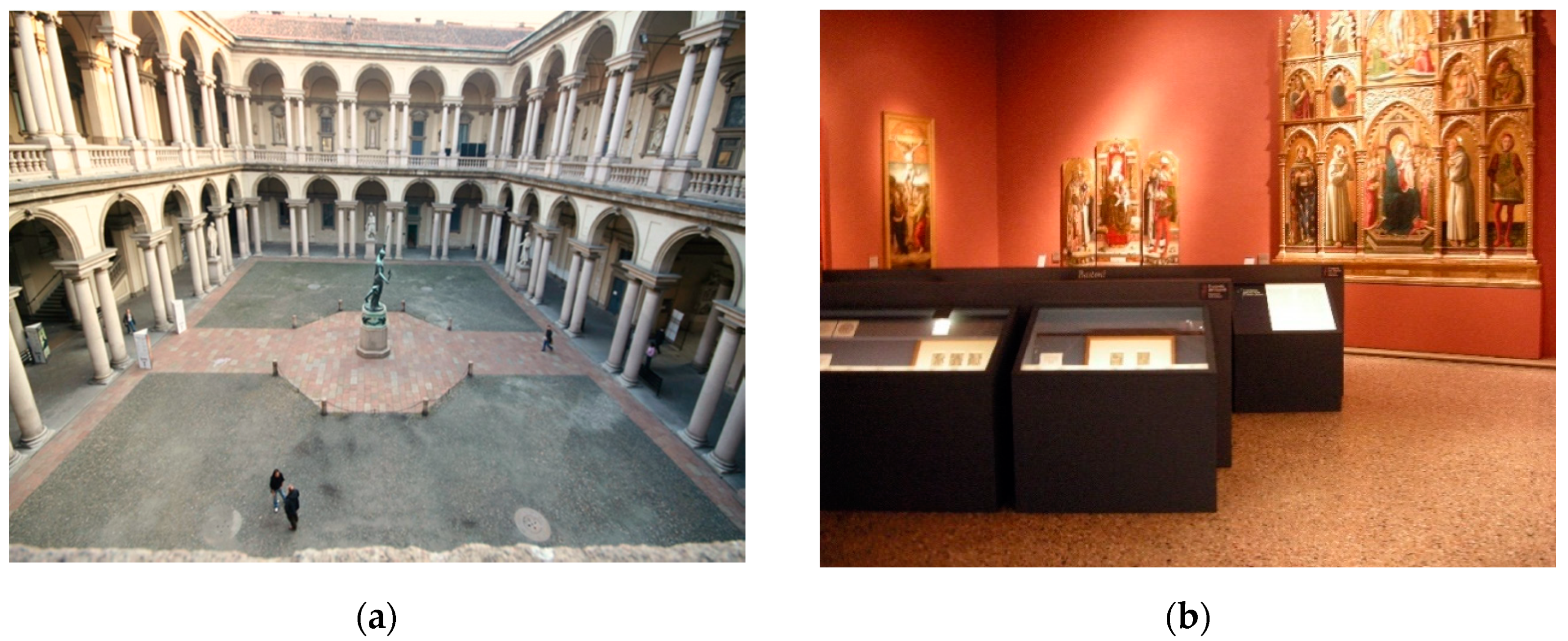

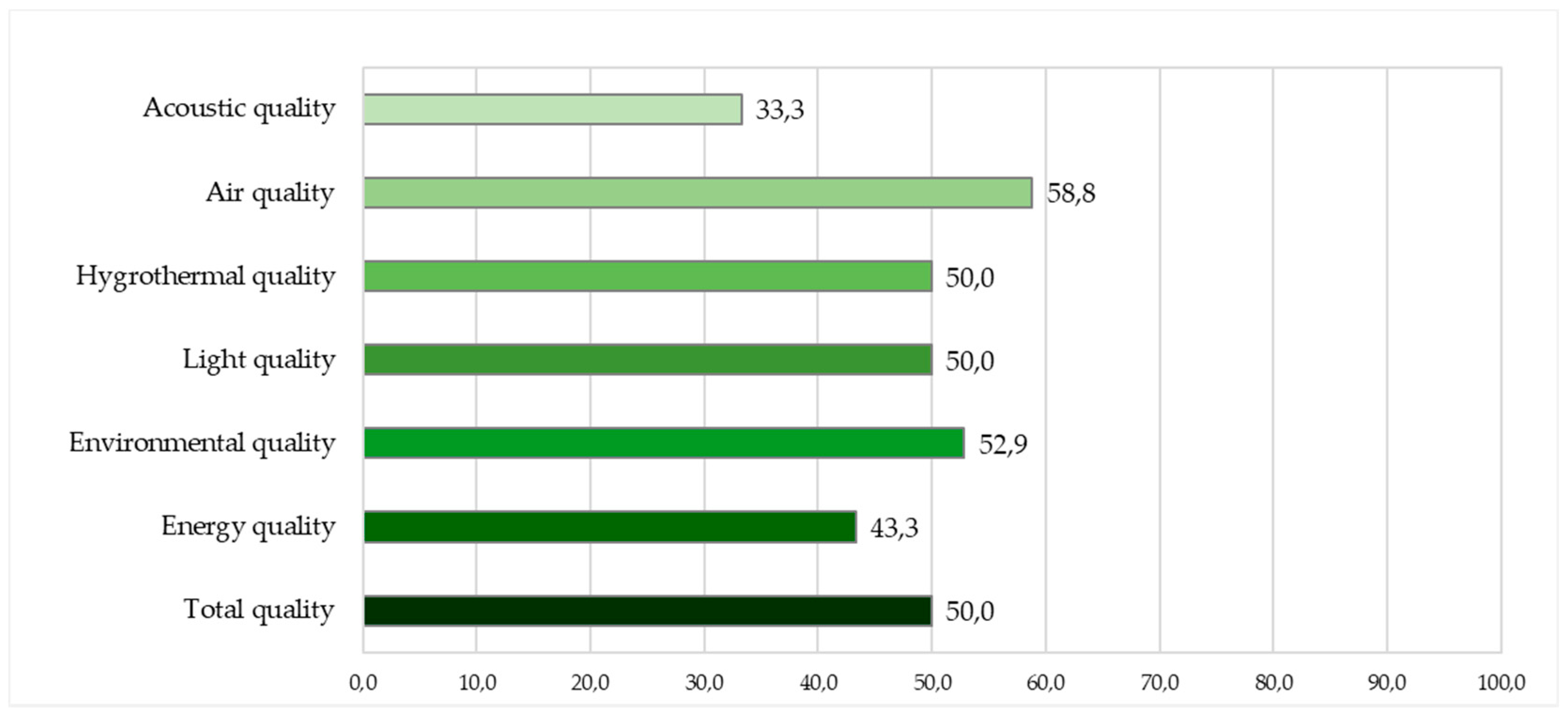

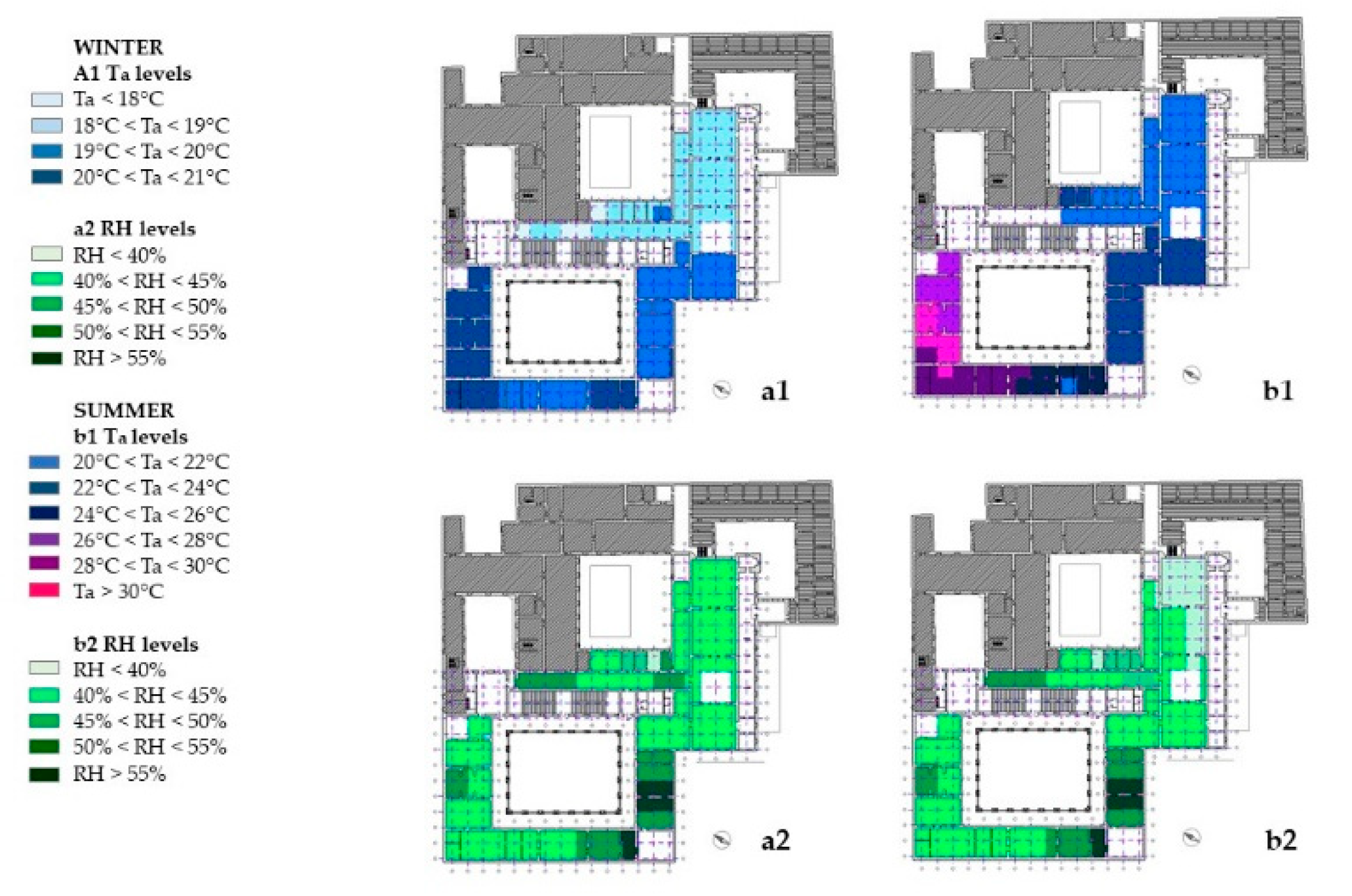
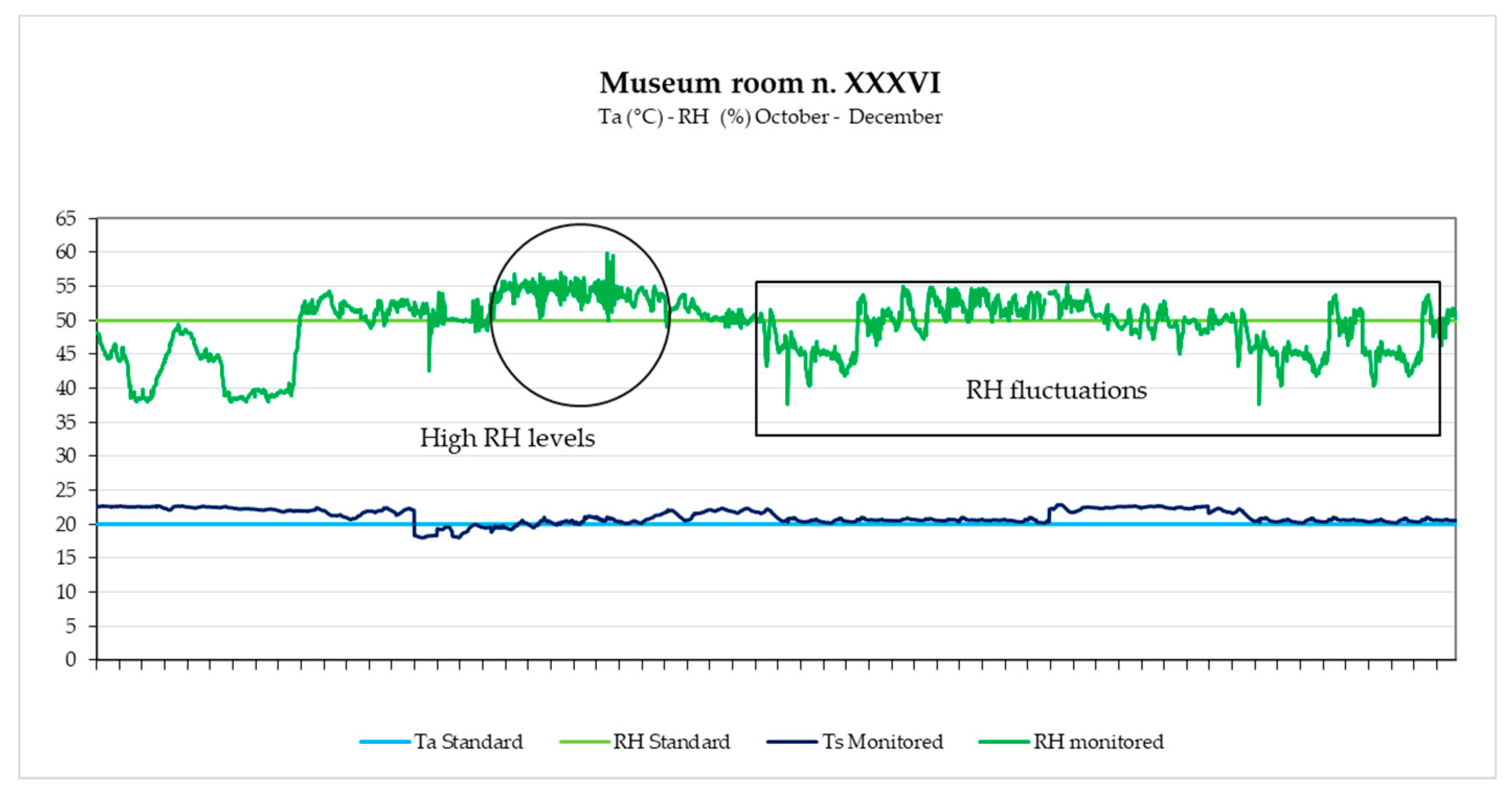
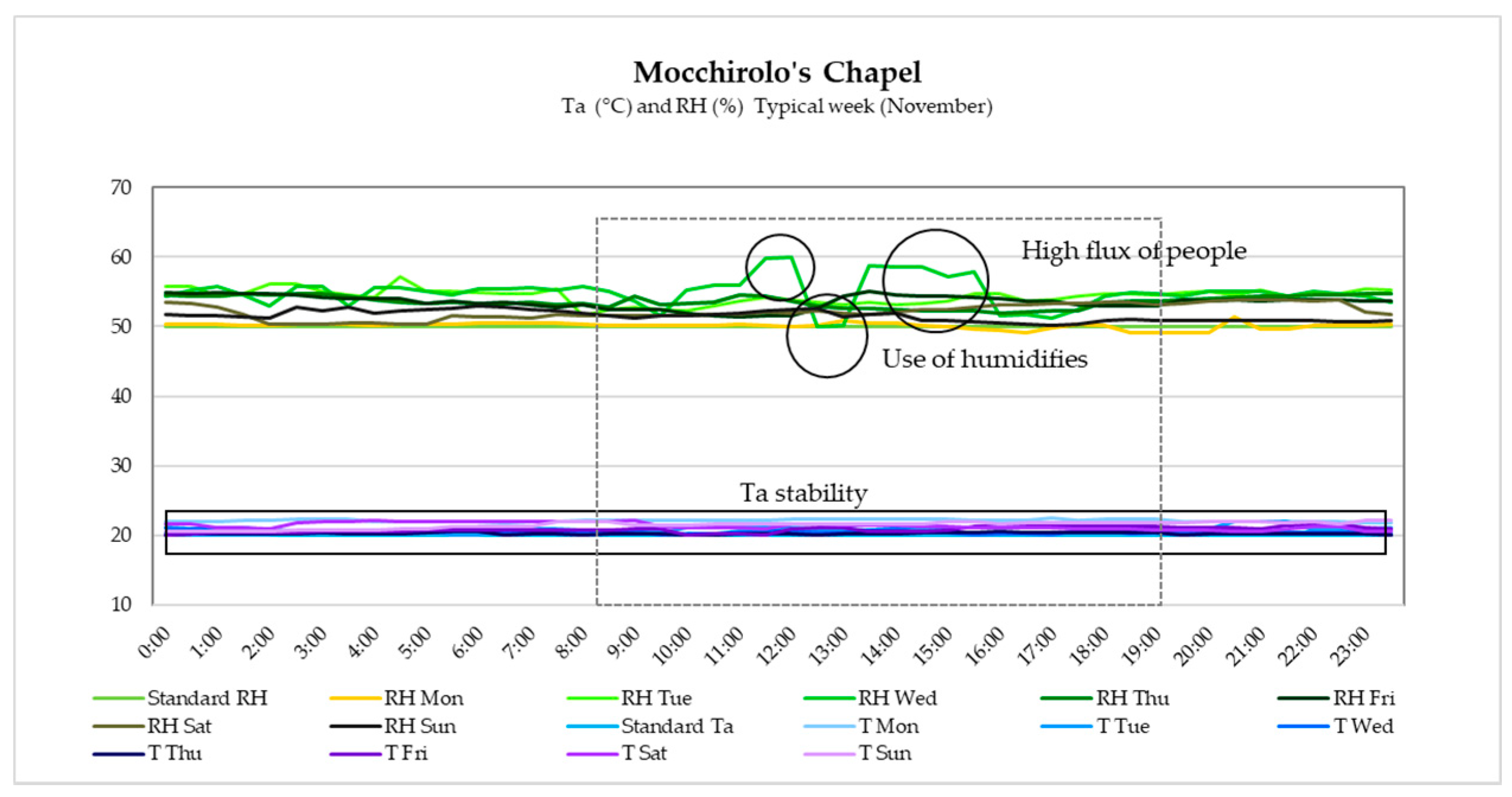
| Category of Control | Building Class | Building Construction | Type of Building | Building Use | System Used | Limit of Climate Control | Class of Possible Control |
|---|---|---|---|---|---|---|---|
| Partial control | IV | Heavy masonry or composite walls with plaster Tight construction, storm windows | Finished house, church, meeting house, store, inn, some office, buildings | Staff isolated rooms, gift shops. Walk-through visitations only. Limited occupancy. No winter use | Ducted low-level heat, Summer cooling, on/off control, DX cooling, some humidification, reheat capability | Basic HVAC | B (if benign climate) C (if mild winters) D |
| Climate controlled | VI | Metal wall construction, interior rooms with sealed walls and controlled occupancy | Vaults, storage rooms, cases | No occupancy, access by appointments | Special heating, cooling, and humidity control with precision constant stability control | Special constant environments | AA A Cold Cold Dry |
| Parameter | Specific Data | Standard Requirements | ||
|---|---|---|---|---|
| Preventive Conservation | Human Comfort | Compatibility | ||
| E [lux] | Light-sensitive | <50 | >300 | I |
| Less light-sensitive | <200 | P | ||
| Not light-sensitive | >300 | P | ||
| UVmax [MW/lm] | Light-sensitive | <30 | - | F |
| Less light-sensitive | <75 | F | ||
| Not light-sensitive | <200 | F | ||
| EE [Kluxh/year] | Light-sensitive | <200 | - | F |
| Less light-sensitive | <650 | F | ||
| Not light-sensitive | - | F | ||
| DF [%] | 0.5–2 | >2 | P | |
| G [-] | - | 1.15 | F | |
| TI [K] | - | 3000–4000 | F | |
| Ra [-] | - | >85 | F | |
| Ta [°C] | 18–24 | 20–26 | F | |
| ΔTa [°C] | Daily | ±2 | - | F |
| Seasonal | ±9 | F | ||
| To [°C] | Winter | - | 18–20 | F |
| Summer | 22–25 | F | ||
| Ts [°C] | On walls | - | 14–25 | F |
| On floors | 19–28 | F | ||
| Tmr [°C] | - | 17–21 | F | |
| RH [%] | 20–45 | 35 ÷ 45 | P | |
| ΔRH [%] | Daily | ±3–±5 | - | F |
| Seasonal | ±10 | F | ||
| va [m/sec] | 0.1–0.25 | - | F | |
| Gaseous pollutant emissions | SOx [mg/m3] | <10 | - | F |
| NOx [mg/m3] | <10 | F | ||
| O3 [mg/m3] | <2 | F | ||
| CO [%] | - | <0.003 | F | |
| CO2 [%] | - | <0.15 | F | |
| Formaldehyde, formic acids, benzene, PM10 [μg/m3] | - | - | F | |
| Solid contaminants [-] | Eff 85% on Eurovent 4/5 | - | F | |
| R [l/s people] | - | >7.8 | F | |
| Microbes, bacteria and fungi [CFU/m3] | - | Absence | F | |
| Mold, pollen [-] | - | Absence | F | |
| Pests [-] | - | Absence | F | |
| Radon [Bq/m3] | - | - | F | |
| Category of Object | Standard Requirements for MPP | Real Conditions (LTM) | ||||||||
|---|---|---|---|---|---|---|---|---|---|---|
| Conservation | Human Comfort | |||||||||
| Emax [lux] | UVmax [μW/lm] | Ta [°C] | RH [%] | Emin [lux] | Ta [°C] | RH [%] | E [lux] | Ta [°C] | RH [%] | |
| Watercolor gouache pencil charcoal pastel | 50 | 75 | 19–24 | 45–60 | Storage room: no occupancy | 50 | 20 | 50 | ||
| Painting on canvas, wood, panel | 150 | 75 | 19–24 | 40–55 | >300 | 19–26 | 45–55 | 50 | 16–21 W 25–30 S | 45–55 W 55–65 S |
| Wax sculpture | 150 | 75 | <18 | - | 300–400 | 20–24 | 55–60 | |||
| Stone terracotta | - | - | 15–25 | 20–60 | 300–400 | 16–26 | 55–60 | |||
| Bronze | - | - | 15–25 | 20–60 | 300–400 | 16–26 | 55–60 | |||
| Frescoes | 150 | 75 | 10–24 | 55–65 | 200–250 | 22–24 | 50–60 | |||
| Painting on detached walls | 150 | 75 | 10–24 | 45–50 | 300 | 22–24 | 50–55 | |||
| Type of User | Rooms | Problems Point Out in the Comfort Analysis | |
|---|---|---|---|
| Summer | Winter | ||
| Museum attendants | I–XV | Thermal comfort | |
| High thermal excursion | |||
| XVI–XXIX | - | High RH | |
| High Ta and RH | Thermal comfort | ||
| Insufficient ventilation | High thermal excursion | ||
| High thermal excursion | |||
| High RH | |||
| Perception of absence of HVAC systems | |||
| Unbeatable Ta | Low Ta | ||
| Insufficient ventilation | - | ||
| National museum visitors | Entire museum | No visual comfort | |
| High thermal excursion | Hygrothermal comfort | ||
| High Ta | - | ||
| Excessively uniform E | - | ||
| International museum visitors | Entire museum | High Ta | Hygrothermal comfort |
| Absence of visual comfort | Visual comfort | ||
| Not enhanced visual impact | Low E | ||
| Original Design | Modifications | Environmental Risks | Recommendations | Adjunctive Tests |
|---|---|---|---|---|
| Replacement of the original skylights | Replacement of curtains and skylights with glass-chamber and UV-filters | High heat loss and air infiltrations from skylights | To seal the skylights To insert a well-isolated curtain or a low-emissivity coating on skylights To perform an energy audit | Blower door test (BDT) IR-thermography (IRT) |
| Non-filtered air from windows | To verify the pollutant concentration | Pollutant concentration monitoring | ||
| To keep surfaces clean | ||||
| To use dust covers without visitors | ||||
| To evaluate the pollution filtering in HVAC | ||||
| To use portable air-filters with activate carbon filters | ||||
| High E for conservation standards | To not reduce E To reduce EE respecting the conservative standards To verify UVmax To verify the conservation state of UV filters To replace UV-filters where is necessary To reduce EE using shutters or filters | Visual analysis UV and IR monitoring | ||
| Closure of all windows | Opening of the existing windows | Visual discomfort Low E for human comfort | To rotate the artworks between museum and storage rooms | E and Ta monitoring |
| To use window coverings | ||||
| Opening of vaults in the entrance hall | - | High E for conservation | To not reduce E To reduce EE To rotate the artworks between museum and storage rooms | E monitoring |
| Replacement of floors, walls, and baseboards | - | No problem | - | - |
| Refurbishment of the roof | - | No problem | - | - |
| Wall plastering (bright yellow plaster) | New wall plastering | Too uniform luminance | To create visual centers To emphasize the masterpieces with chromatic design | Questionnaires, POE |
| Changes in the original chromatic atmosphere | To use bright warm plasters in the same color tones of artworks | |||
| Selection of decorative materials | - | No problem | To create esthetic centers on these materials | - |
| Insertion of fluorescent light sources | Replacement of original sources with halide lamps Addition of electronic regulators | High E for conservation standards | To not reduce E To reduce EE To reduce the display time for fragile artefacts To define the maximum EE for each artefact | E monitoring |
| Too uniform luminance | To recreate the original chromatic atmosphere To realize a new lighting design with Tc of lamps correlated with artworks color tones To improve light contrast To use high energy performance light sources | Questionnaires, POE Luminance monitoring | ||
| Thermal fluctuations on objects | To verify Ta fluctuations on high sensible artifacts To check anti-IR filter on the lamps To use low-T lamps To use external or integrate lamps in display-cases | Indoor Ta monitoring | ||
| HVAC systems | Several modifications | High seasonal ΔTa fluctuation for conservative standards | To valorize the original building features To check HVAC system periodically | Ta monitoring |
| Overheating and high Ta in summer | To verify the benefits of cross-ventilation strategies | Questionnaire, POE | ||
| Absence of hygrometric project | Insertion of portable humidifiers | High RH level | To define clear guidelines with RH levels for each typology of object To evaluate the use of active RH regulation systems | RH indoor monitoring |
| RH fluctuations in autumn and winter | To valorize the original building features To check daily RH fluctuations To control the flux of visits To switch-on the humidifiers with RH < 30% To insert passive RH regulation systems To use dry cleaning | |||
| New storage room without climate control | Addition of climate control storages | No problem | - | - |
| Reconstruction of the Mocchirolo’s Chapel | New lighting design | High E level | To reduce EE | E, Ta, RH monitoring Questionare, POE |
| - | RH fluctuations | To regulate visits | ||
| Absence of conservation program | Internal conservation policy | No problem | To add energy policies in MPP | - |
© 2020 by the author. Licensee MDPI, Basel, Switzerland. This article is an open access article distributed under the terms and conditions of the Creative Commons Attribution (CC BY) license (http://creativecommons.org/licenses/by/4.0/).
Share and Cite
Lucchi, E. Environmental Risk Management for Museums in Historic Buildings through an Innovative Approach: A Case Study of the Pinacoteca di Brera in Milan (Italy). Sustainability 2020, 12, 5155. https://doi.org/10.3390/su12125155
Lucchi E. Environmental Risk Management for Museums in Historic Buildings through an Innovative Approach: A Case Study of the Pinacoteca di Brera in Milan (Italy). Sustainability. 2020; 12(12):5155. https://doi.org/10.3390/su12125155
Chicago/Turabian StyleLucchi, Elena. 2020. "Environmental Risk Management for Museums in Historic Buildings through an Innovative Approach: A Case Study of the Pinacoteca di Brera in Milan (Italy)" Sustainability 12, no. 12: 5155. https://doi.org/10.3390/su12125155
APA StyleLucchi, E. (2020). Environmental Risk Management for Museums in Historic Buildings through an Innovative Approach: A Case Study of the Pinacoteca di Brera in Milan (Italy). Sustainability, 12(12), 5155. https://doi.org/10.3390/su12125155




